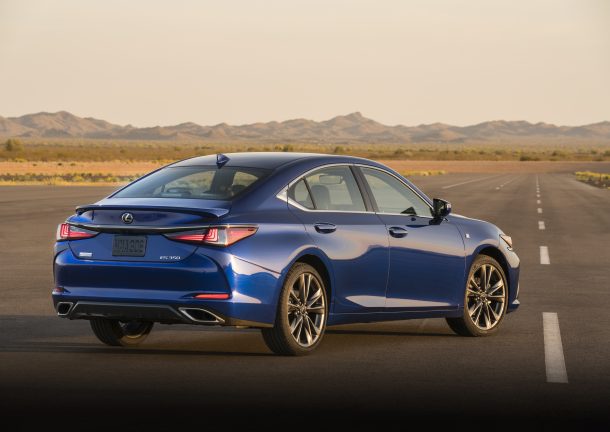2019 Lexus ES: Luxo-Avalon Reveals Its Pricing

Long regarded as the pinnacle of worry-free premium transport, the Lexus ES throws off its dowdy clothes for 2019 in favor of a new, sportier look. It’s a makeover shared with its platform-mate, the Toyota Avalon, and the two large sedans both call dibs on the same V6 engine, four-cylinder hybrid powertrain, and eight-speed and continuously variable automatics.
The mission of this ES is not just to compel existing owners to return to the dealer for another go-around. It wants fresh blood — hence the new sheetmetal and addition of an F Sport model. To help keep both sets of buyers in its good books, Lexus hasn’t gone wild with the pricing. One version actually sees a price decrease for 2019.
Base sticker for a 2019 ES 350 is $39,500, sans delivery, representing a $550 uptick over the 2018 model. For this price, buyers gain a 3.5-liter V6 generating 302 horsepower and 267 lb-ft of torque, harnessed through the eight-speed. That’s an increase of 34 hp and 19 lb-ft over the outgoing model. Lexus claims combined fuel economy rises 2 mpg (to 26 mpg), helped by the retirement of the previous-gen model’s six-speed automatic.
Should buyers be of the green persuasion, the hybrid ES 300h model drops in price by $510, stickering for $41,310. This variant also sees power and economy increases. Output from the 2.5-liter four-cylinder/electric motor combo rises to 215 hp, while combined fuel economy jumps 4 mpg ( to 44 mpg). While driving the model’s Avalon sibling in April, this combo proved decently powerful and gratifyingly smooth.
As sedan sales aren’t what they used to be, Lexus’ reworking of the ES went beyond simply smoothing out its conservative body. Buyers afraid of rear- or all-wheel drive can now spring for an F Sport model. This brings mildly more aggressive looks and Adaptive Variable Suspension (AVS) on board, complimenting the front-drive-only sedan’s new multi-link rear. Metallic cabin trim and other appearance flourishes hide the fact that the F Sport’s powertrain remains the same as the stock ES 350, though you’ll pick up a wider variety of drive modes.
As we all know, ES owners are known for wanting to fine-tune their steering feel, throttle response, damper stiffness, and shift points. The ES F Sport rings in at $44,035 before delivery.
The 2019 Lexus ES family arrives at dealers in September. Over the first half of 2018, ES sales fell 8.7 percent compared to last year, though it’s still — by far — the Lexus division’s best-selling passenger car. After reaching a post-recession high water mark of 72,508 U.S. sales in 2014, ES volume fell to 51,398 units in 2017.
[Image: Lexus]

More by Steph Willems
Latest Car Reviews
Read moreLatest Product Reviews
Read moreRecent Comments
- ToolGuy If these guys opened a hotel outside Cincinnati I would go there to sleep, and to dream.
- ToolGuy Michelin's price increases mean that my relationship with them as a customer is not sustainable. 🙁
- Kwik_Shift_Pro4X I wonder if Fiat would pull off old world Italian charm full of well intentioned stereotypes.
- Chelsea I actually used to work for this guy
- SaulTigh Saw my first Cybertruck last weekend. Looked like a kit car...not an even panel to be seen.



































Comments
Join the conversation
reliability not an issue. Buy a MBZ S series. Issue resolved.
The front end on that car is truly ugly.